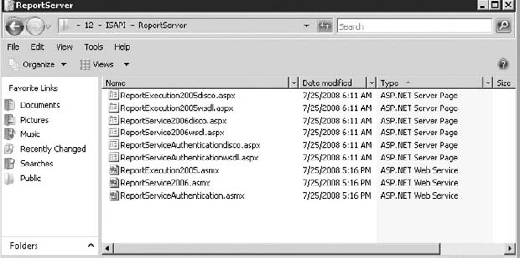9.2. Automating Report Deployment
At times it can be quite challenging to satisfy customers' reporting needs using the out-of-the-box functionality that SQL Server Reporting Services 2008 offers. The main focus of Reporting Services is to provide an extensible framework and a new level of interoperability that enables developers to build custom Business Intelligence applications more easily than before. Developers can use any developer tool or platform to interact with a report server instance and its hosted reports, as long as those tools or platforms work with SOAP, WSDL, and UDDI capabilities. This makes it easier to create reports that leverage packaged or custom applications in almost any environment. It's all about making developers' tasks more seamless and their life much easier, right? If it's easy to use, more people will use it!
9.2.1. Anatomy of the ReportServer Folder
As part of the installation of the Reporting Services Add-in, a bunch of proxy endpoints are created in the 12/ISAPI/ReportServer folder, as shown in Figure 9-3. These SOAP APIs provide several web service endpoints that developers can use to manage a report server instance configured in SharePoint integrated mode or simply interact with reports in their custom reporting solutions.
Figure 9-3. Figure 9-3

NOTE
The SQL Server 2000 report server proxy endpoint, which was deprecated in SQL Server Reporting ...
Get Professional Microsoft® SharePoint® Server 2007 Reporting with SQL Server 2008 Reporting Services now with the O’Reilly learning platform.
O’Reilly members experience books, live events, courses curated by job role, and more from O’Reilly and nearly 200 top publishers.

